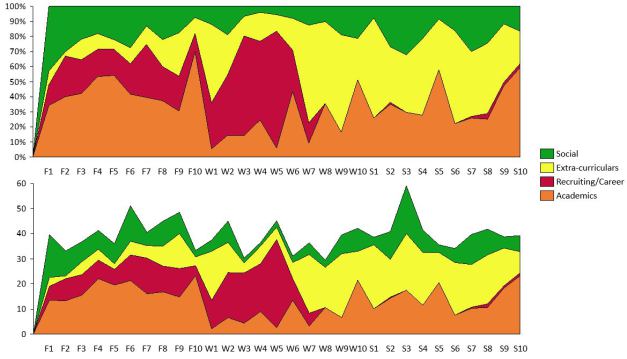So what does this all mean in terms of time spent?
I thought I’d show what all of these notes looked like in action. I’ve written about this a few times, but aside from just recording meetings, I generally record productive time on my calendar. If I’ve spent 90 minutes studying but felt like I did 60 minutes of productive work, I generally store that on my calendar. At the end of the week, I add up the time spent on each priority and look at how I spent my week. It is always very illuminating. Over time, I added more nuance – e.g. tracking group time vs. solo study time, etc. As I could go on about this topic for hours, I thought I’d share two graphs and what they mean.
These two graphs show how I spent time in the year. I don’t track time spent with framily or with wife/myself. This is strictly for the “work” part of my life. It is an approach that’s added incredible value considering the time investment (roughly 30 minutes per week). I’ve continued to do this in my internship and it is among the better things I do. A few notes:
Both graphs have the same data – the top graph is a 100% graph while the bottom is in absolute hours.
F1 = 1st week in the Fall quarter. W = Winter, S = Spring
As you can see, my internship search ended Week 6 of the winter quarter and nearly all of that time got replaced by extracurriculars (and a little bit more social – but not much more).
I generally get about 35 “productive” hours in a week. This number assumes meetings are productive. I try to make sure they are. But, of course, this is chainsaw art and not fine – it is granular enough to work for my purposes.
My academic numbers don’t include 12 hours spent in classes. I take that as a base-case.
As you can see, my academic hours spike around Weeks 9 and 10. I spent a lot more time studying in the fall. I took three courses (one less than the usual four-course load) in the winter – even so, I didn’t study all that much in the winter.
I have some more nuanced stats but won’t spend any more time on this. I geek out on this stuff, and I recognize that it isn’t for everyone.
I have written a lot about prioritization in school. And, hopefully, this brings those ideas to life.
Finally, since this post is all about my personal advice, I’d like to finish with three ideas I’ve found useful:
1. Spend energy and time on things you value or consider important.
The first step here is to determine which of these priorities matter to you. Academics, for example, clearly matters to me. It doesn’t for everyone. But understanding what matters to you is the first step to allocating your energy and time – your most valuable resources. Everyone who goes to a decent program will tell you that it often gets overwhelming. I think of it as preparation for life as a business leader. If you walk out of school having learned to prioritize things that matter, that’s a great lesson to learn.
2. You can’t win them all.
Business school can often feel like high school. You can easily spend hours worrying about your popularity, social standing and/or what you are missing out on (a.k.a FOMO or fear of missing out). The first step here is to acknowledge that school is the same as life – you aren’t going to get along with everyone and not everyone’s going to like you. That’s OK. Just be yourself. Everyone else is taken.
3. No one owes you anything.
It is tempting to walk in thinking that the school owes you a great experience for the fees you paid, that your group mates owe you for your selfless dedication, and so on. I think a better way to approach this is to just remind yourself that nobody owes you anything. You’re in a great environment that you can mold to suit your needs and style. That, in itself, is a great opportunity.
Like all good things, your experience is what you make of it.
Make it meaningful.
Make it count.
Rohan Rajiv is a second-year student in Kellogg’s Full-Time Two-Year Program. Prior to Kellogg he worked at a-connect serving clients on consulting projects across 14 countries in Europe, Asia, Australia and South America. He blogs a learning every day, including his MBA Learnings series, on www.ALearningaDay.com.





